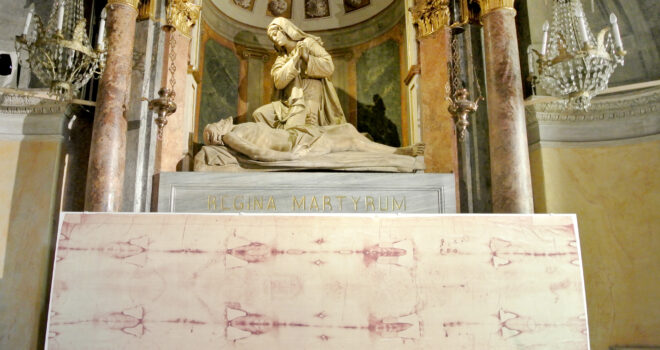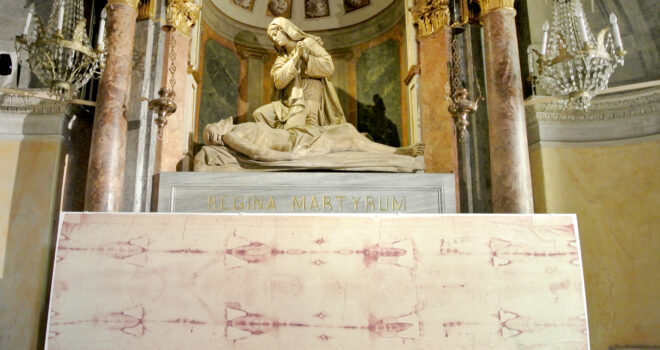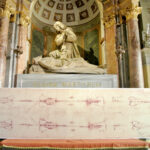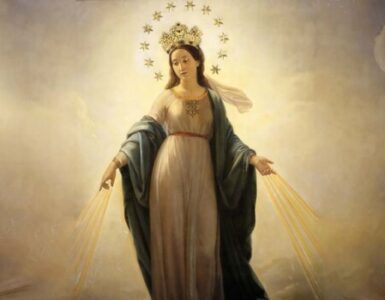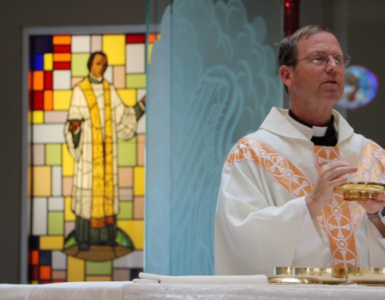It is quite obvious to most Christians, that in the present hour Christianity is under attack from a sector of our society, which hates what we believe in, and acts as though we have no right to our own beliefs. Furthermore, the cornerstone of our faith that we share in common as Christians is a focal point of an insidious attack. And that focal point is the denial of the historical reality of the resurrection of Christ from the dead. Destroy that central belief and what is left?
What we must never lose sight of, is that the resurrection of Christ from the dead was the culminating and decisive event, in a trilogy of events, which changed the course of human history. These three events which are intrinsically linked together, as though they form one continuous Divine action, are our Lord’s incarnation, when the Word became flesh, his passion and death, and lastly his glorious resurrection. The intrinsic link among these three events is made manifest in the realization that it is impossible for one of these events to have occurred without the other two also having occurred. Think for a moment on that. They were all part of God’s plan for our salvation.
However, in this article my focus will be on the culminating and decisive event, that being the historical reality of the resurrection of Christ from the dead. Afterall, one cannot overstate the importance of Christ’s resurrection from the dead to our own religious beliefs, inclusive of our own resurrection from the dead. Which gives rise to the ultimate question, must we accept this critical article of our Christian faith on faith alone? And the answer is a resounding no. It is by faith and reason that we can best determine the truth of the historical resurrection of Christ from the dead.
In his encyclical letter, entitled “Faith and Reason”, Pope St John Paul II states “Faith and reason are like two wings on which the human spirit rises to the contemplation of truth; and God has placed in the human heart a desire to know the truth, in a word to know himself, so that, by knowing and loving God, men and women may also come to the fulness of truth about themselves”.
Logic suggests that God would not only give us the means to accept the truth of the resurrection on faith but also the intellectual capacity to reason its reality as well. In this article, I would like to submit for your consideration seven arguments in support of the historical reality of Christ’s resurrection from the dead.
The first and most obvious argument is the existence of written eyewitness testimony of the numerous encounters, many of his disciples had, with the risen Christ. These encounters are detailed in the four Gospel resurrection accounts as well as Paul’s reference to “an encounter that more than five hundred brothers at once had with the risen Christ” (1 Cor 15:6). These disciples are his eyewitnesses, who ate and drank with him after his resurrection. Whose lives were forever changed and who bore witness to the historical truth of Christ’s resurrection even to the shedding of their own blood.
The second argument in support of the historical resurrection of Christ is the many references to his resurrection in prophecies contained in the books of the Old Testament. In the Old Testament the term Messiah, a Hebrew word meaning “anointed”, is synonymous with the term Christ, which is the English translation of the Greek word Christos. You may be surprised to learn that there are 353 prophecies pertaining to the Messiah, contained in the books of the Old Testament, which are fulfilled in the life, death, resurrection, and ascension of Jesus.
These prophecies include but are not limited to the following:
- that he would be born of the tribe of Judah (Gen. 49:10);
- that he would be born from the line of King David (2 Sam. 7:16);
- that he would be born of a virgin (Isa. 7:14);
- that he would be born in Bethlehem (Mic. 5:2);
- that he would be born during the fourth kingdom to rule over Israel, which was the Roman Empire (Dan. 2:44-45);
- that he would be called out of Egypt (Hos. 11:1);
- that a herald would announce his coming, in the person of John the Baptist (Mal. 3:1);
- that he would be a miracle worker (Isa. 35:5-6);
- that he would make a triumphant entrance into Jerusalem riding on a donkey (Zech. 9:9);
- that he would institute a new and eternal covenant (Jer. 31:31);
- that he would be betrayed by a friend for thirty pieces of silver (Zech. 11:12-13);
- that he would die a cruel and agonizing death for the sins of others (Isa. 53:5-12);
- that he would rise from the dead on the third day (Hos. 5:15b-16:2); and
- that he would ascend into heaven (Dan. 7:13-14)!
All of these and more were prophesied, by prophets of the Old Testament, hundreds to well over a thousand years before Christ’s incarnation.
In fact, there are twelve Old Testament prophecies that pertain specifically to Christ’s resurrection. The one referenced above from the Book of the Prophet Hosea is but one of these prophecies. A couple of other prophecies that refer to his resurrection are: “For you will not abandon my soul to the netherworld nor will you suffer your Holy One to see corruption.” (Ps. 16:10); “He it is who shall build a house for my name, and I will establish his royal throne forever. I will be a father to him, and he shall be a son to me” (2 Sam. 7:13-14).
Now what are the odds that all of these prophecies were fulfilled except those that referred to his resurrection from the dead? To what purpose were these prophecies made in the first place, if not to convey to us, God’s premeditative plan for our salvation. Premeditation goes to intent to do something. In this case, the intent was to save us from our sins by sending the only one who could accomplish it by his sanctifying death, and resurrection. And that our salvation is clearly predicated on Christ’s resurrection from the dead. This is made very clear in the prophecy of Hosea referred to above. “He will revive us after two days; on the third day he will raise us up, to live in his presence.”
Now let me turn to the third argument which is the change in the behavior of the Apostles from before to after the resurrection. Before the resurrection, all but John, acted in a cowardly manner at Jesus’ arrest, fleeing the Garden of Gethsemane and in the case of Peter, vehemently denying even knowing Jesus three times. Contrast that with their behavior after the resurrection and their anointing by the Spirit on Pentecost. They traveled the known world spreading the Good News of the Gospel to all they met testifying that they were eyewitnesses to Christ’s resurrection. All but John would die a martyr’s death. Three of whom, Peter, Andrew, and Bartholomew would die very cruel and agonizing deaths. And none of them, even in the face of death, recanted their eyewitness testimony to the resurrection.
But the most dramatic conversion of one’s behavior has to be reserved for the Apostle Paul. Afterall, before his encounter with the risen Christ on the road to Damascus he was a zealous persecutor of the early Church and after that encounter its most fearless, hard-working, and zealous evangelist. The common denominator in all of these behavioral transformations was their encounter with the risen Christ.
The fourth argument is more practical in nature. It deals with the Roman sentries posted at the tomb. The relevant passage of sacred scripture pertaining to this argument comes from Matthew’s Gospel (Matt.27:62-66). The passage refers to the chief priests and the Pharisees having had an audience with Pilate where they requested a Roman guard be placed at the tomb of Christ. This request was made to prevent Jesus’ disciples from stealing his body and then claiming he had been raised from the dead. Pilate granted their request, and a guard of Roman sentries was posted at the tomb as requested.
Now one has to ask why the chief priests and the Pharisees made this request of Pilate in the first place? Afterall, the chief priests and Pharisees had their own soldiers and guards? Recall in the account of Jesus’ arrest, in the Garden of Gethsemane, it was the Temple guards that made the arrest. Why not use the Temple guards, which the chief priests controlled, to guard the tomb? Why did they rely on a foreign occupier’s soldiers to guard it?
The answer is likely twofold. First, it was a high sabbath which carried with it a prohibition on doing any work and naturally the Temple guards were Jewish. But secondly, and possibly of greater significance, the Roman legionnaire was a far more professional soldier than the Temple guards. They were routinely posted as sentries to guard palaces, forts, encampments as well as prisoners. All Roman legionnaires knew the penalty for falling asleep while on sentry duty. The penalty was death, and that punishment was meted out swiftly. Add to that, the chief priests and Pharisees would have, in all likelihood, told these Roman sentries, just as they had told Pilate, that they should be on high alert on the third day for Jesus had said he would rise on the third day.
The truth of the matter is the Roman sentries would never have fallen asleep while guarding the tomb knowing the penalty. Yet that is what the chief priests told them to say when some of the guard appeared before them after the resurrection. Bribing the Roman soldiers and promising their support with Pilate to avoid the punishment.
The fifth makes the supposition, for argument sake, that if Jesus’ disciples did, in fact, steal the body while the Roman sentries were asleep, his burial site would have been extremely difficult to be kept a secret. Certainly, his mother and disciples would have, in all likelihood under this supposition, venerated the site and word would have spread of its location. But the counter to this supposition, is that no such burial site exists nor has been known to exist in history nor even rumors, to such a burial site, been circulated.
Which leads us to the sixth argument in support of the historical reality of Christ’s resurrection from the dead, namely the passage of time. If one were to summarize a frequently used, subtle but effective, line of attack on Christianity it’s that Jesus was a good person who got caught up in a political struggle between the Romans and the Jews and was executed for this misfortunate circumstance. Simply put, humanize him, remove the glory of his Divinity! His death made unfortunate, and his resurrection denied!
Nearly two thousand years have passed since the resurrection of Christ from the dead and there are nominally two billion Christians in the world today. Yes, the level of their faith varies widely but they continue to be identified as Christians! And that affiliation of faith has everything to do with their belief in the resurrection of Christ from the dead. No matter how hard the enemy has tried to undermine this central belief of our faith, it still has the power to bind us as one.
Can you think of any organization or faith, other than that of the Jewish faith, that can claim a two thousand year ancestry? And both Christianity and Judaism were founded by God.
In chapter 5 of Acts of the Apostles, the renowned Jewish rabbi Gamaliel addressed the Sanhedrin with a warning “that if this endeavor (Christianity) is of human origin it will destroy itself. But if it comes from God, you will not be able to destroy them; you may even find yourselves fighting against God. (Acts 5:38-39)”. Paul certainly learned the wisdom of that instruction! And two thousand years and two billion people also give witness to the prophetic nature of Gamaliel’s warning.
You may ask, all these arguments are compelling but is there any physical evidence to support the historical reality of the resurrection of Christ from the dead, which is the subject of my seventh argument.
In John’s Gospel, when Peter and John ran to the tomb, as Peter entered the tomb first he “saw the burial cloths there, and the cloth that had covered his head, not with the burial cloths but rolled up in a separate place” (Jn 20:6-7). These two separate cloths have names and are still in existence today. They are referred to as the Holy Shroud of Turin and the Sudarium of Oviedo, respectively. Not only that, but they are both dated to the time of Christ and have origins in the Middle East.
The Sudarium is the cloth they placed over the face of our Lord at the time of his death while on the cross. For Jews at that time, to look upon a dead person who had been put to death made one ceremonially unclean, and ineligible to participate in Temple worship. A ritual had to be performed by a priest to make the person ceremonially clean in order to resume Temple worship. Recall the parable of “the Good Samaritan”. In that parable, a priest and a Levite walk to the other side of the road to avoid coming into close contact with someone they thought had been murdered for just this reason. As a result, they would customarily cover the deceased person’s head immediately upon death. Joseph of Arimathea and Nicodemus removed the Sudarium when they arrived in the tomb with the body of Jesus and set it aside just as Peter had found it.
The Holy Shroud, which is the burial cloth of Jesus, has the image of a crucified man on it bearing the nail marks in his hands and feet. But it also reveals the marks of the scourging which are clearly visible by the human eye. In point of fact, there is no record of anyone in recorded history who was crucified after first being scourged other than Jesus Christ. Recall, it was Pilate’s intention to punish Jesus severely, in the hopes of avoiding his crucifixion.
Now let me cover three facts these two cloths have in common. First, both cloths contain a rare blood type, AB+, which only 5% of the world’s population has. If as some claim, these cloths are forgeries, the odds that these ancient cloths would both have such a rare blood type, before blood types were discovered, is a quarter of one percent (5% times 5%)!
Furthermore, scientists have superimposed the blood stains from the Sudarium onto the face of the Holy Shroud and made a startling revelation. There are twenty points of correlation found from the blood stains appearing on the two cloths. In any court of law in the world to submit corroborating physical evidence into court there must be 8 to 10 points of correlation between the pieces of evidence, the Shroud and Sudarium have 20!
Secondly, both cloths contain two types of blood, pure blood and blood mixed with a watery substance. Moreover, the blood mixed with a watery substance were in the identical locations around his nose and mouth on both cloths. This blood mixed with water was seen, by eyewitnesses, when the soldier pierced the side of Jesus with a lance and blood and water flowed out (Jn 19:34). This results from what the medical profession refers to as pericardial effusion. A condition where a person having lost a significant amount of blood suffers hypovolemic shock that causes fluid to gather in a sack around the heart and lungs.
But how did this blood mixed with a watery substance come out his nose and mouth, and how was it found on both cloths? One plausible explanation to the first part of this question has to do with the manner in which Joseph of Arimathea and Nicodemus removed Christ’s body from the cross. If he were removed while the cross remained erect, one of the two would have draped Christ’s body over his shoulder while on a ladder. And if his nose and mouth were below his heart, which would presumably have been the case, to balance the weight of his body, any remaining blood mixed with a watery substance would have been excreted out of his nose and mouth and onto the Sudarium.
Now for the second part of that question. How did this blood mixed with a watery substance end up on both cloths? I’ve given you a plausible explanation for its appearance on the Sudarium but what about the Shroud? Again, one must make a reasonable supposition here. We know that Good Friday was the Jewish preparation day (Jn 19:42), and that the daylight remaining when Jesus died would have been, in all likelihood, no more than three hours. Jews had to be in their homes by sunset for the Sabbath.
Joseph of Arimathea and Nicodemus would have first gone to Pilate to request the body, and Pilate presumably would have required verification of Jesus’ death before granting their request. Once approval was obtained, they would have required the tools necessary to remove the nails securing Jesus’ body to the cross. Then they would have had the difficult task of removing the nails, that pierced his hands and feet, while avoiding further trauma to his body. Then they would have carried his body to the tomb that was nearby, removed the Sudarium from his head, and hastily wrapped his body in the Shroud. Then they would have had to roll the stone in place to secure the tomb. Lastly, they would have returned to their homes by sundown.
That is a lot of activity in a very short period of time. Hence, no time for washing his body. This point is borne out by a passage from Mark’s Gospel, “when after the sabbath was over, Mary Magdalene, Mary, the mother of James, and Salome bought spices so that might go and anoint him” (Mk 16:1). This would explain why remnants of the blood mixed with a watery substance is found on the Shroud of Turin as well as the Sudarium of Oviedo.
The third and final piece of commonality between the two cloths is, that they both have pollens on them that went extinct in the first century, and these pollens only had a common habitat within a thirty mile radius around Jerusalem! Now if these ancient clothes are forgeries how does one explain this!
And now to my last point concerning the miraculous image on the Shroud, scientists have recently determined that the energy required to imprint the image of Christ’s crucified body on to the Shroud would be equal to all the electrical power generation that exists in the world today. Imagine that!
Well there you have it. Seven strong arguments in support of the historical reality of the resurrection of Christ from the dead! They include written eyewitness testimony; twelve Old Testament prophecies, concerning the Messiah’s resurrection from the dead, written hundreds of years before Christ’s incarnation; the behavioral change in the Apostles from before and after the resurrection; that Roman legionnaires would not have fallen asleep while posting sentry duty at the tomb knowing the penalty of doing so; that no known burial site of Jesus exists other than the empty tomb; the passage of time; and lastly the physical evidence from the two cloths found in the tomb after the resurrection that corroborate one another and that the Shroud bears the image of the scourged and crucified body of Christ!
I began this article by saying that, in the present hour, Christianity is under attack. This attack, while multi-pronged, focuses a considerable energy on undermining the historical reality of the resurrection of Christ from the dead. The attack is insidious, as the average person doesn’t recognize the extent of the attack on our faith. Frequently, they humanize Jesus’ miracles, at other times they suggest that Jesus had intimate sexual relationships. It was hard for me to type that, but a number of movies have been made over the last several decades suggesting it, as though it were true, with absolutely no evidence to back up their vile insinuation. All done to humanize Jesus so as to deny his Divinity. With no Divinity there is no resurrection and hence no redemption! So central is the resurrection of Christ as an article of our faith that undermining it weakens the entire structure of the Church.
It’s said that knowledge is power. May the knowledge, of these seven arguments in support of the historical resurrection of Christ, help to empower you to evangelize those whose faith is wanting with respect to the resurrection of Christ. Afterall, as our beloved late great pope said, “Faith and reason are like two wings on which the human spirit rises to the contemplation of truth; and God has placed in the human heart a desire to know the truth”! May these words echo in our hearts and minds in search of God’s truth! And may we receive the grace to defend our faith when called upon to do so!
Image: Turin, Italy – 12 September 2017: exposition of the Shroud by elena castaldi viora on Shutterstock.


